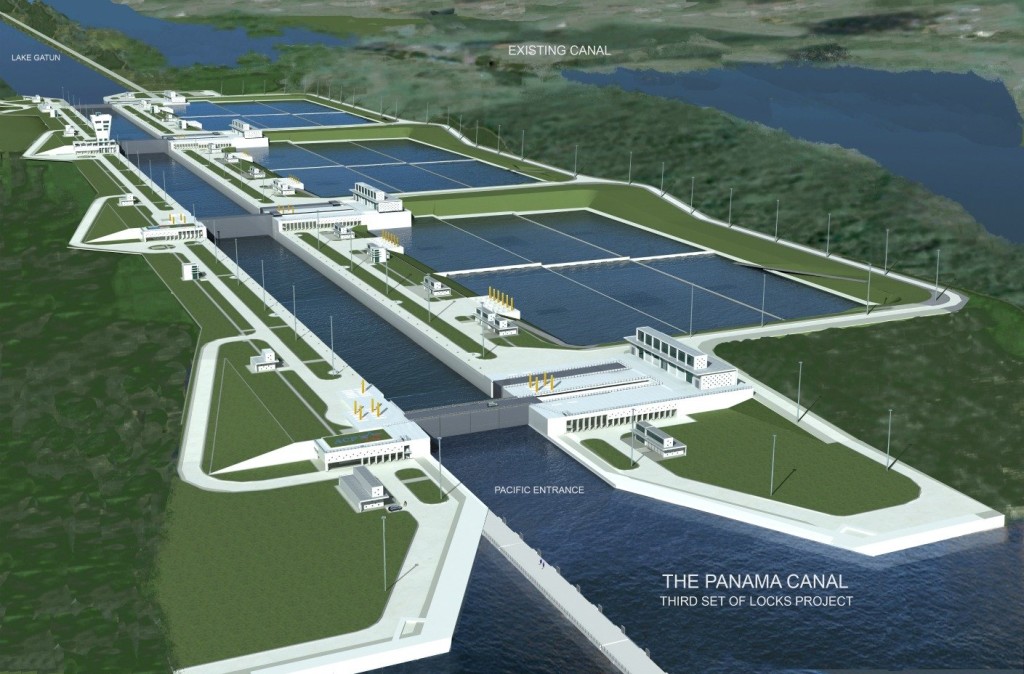Panama Canal: expansion

industrytap.com
The project of expansion of the Panama Canal is a project that will double the capacity of the Panama Canal in 2016, allowing the passage of larger ships. The President of Panama Martín Torrijos presented the plan April 24, 2006, and the Panamanians citizens have given their approval through a referendum with 76.8% of votes in favor 22 October 2006.
The company which has been entrusted with the task of widening the Panama Canal, is the Italian Salini Impregilo, a world leader in the production of Extreme Engineering.
The project involves the construction of a new channel – to complement the existing – will allow the transit of larger ships, increasing commercial traffic in response to developments and the continued expansion of the maritime transport market.
The realization of the Third Set of Locks of the channel allows, in fact, the passage of a higher tonnage ships called Post Panamax, with a capacity up to 12,000 TEU, a length of 366 meters, a width of 49 meters, a draft of 15 meters.
Today the current system of locks allows the passage of the Panamax type vessels, with a capacity of 4,400 TEU, a maximum length of 294 meters, a maximum width of 32 meters and a draft of 12 meters.
In particular, the project involves the construction of two closed in triple jump: a closed triple jump on the Atlantic side and one on the Pacific side.
These closed will allow the lifting of vessels from the level of the oceans to the Gatun Lake (intermediate compared to the two Oceans) and vice versa, in a time of less than two hours.
Each of the three rooms that make up each closed is 55 meters wide, 427 meters long, 18.3 meters deep, and are equipped with systems of sliding bulkhead, horizontally, that overcome the difference in height of about 27 meters between the oceans and Lake Gatun.
As told by the engineer Giuseppe Quarto:
This is one of the most complex works that I have touched directing in my life. Complexity of logistics, production, complexity of the electromechanical part of the work, which is out of the ordinary. A dedicated system has never been done before.
The extension works of the Panama Canal is a matter to be $ 5.25 billion, which is probably at the end will increase to 6 or 7 due to additional costs.
The project also includes the following components:
- Construction of two ends, one will be located on the Atlantic side and another on the Pacific, each with three airtight chambers which include three water basins. The efficient operation and security of the locks is regulated and guaranteed by gates type “doors Horizontal Scrolling” that (similarly to the doors type “Vinciane” of existing closed) are of proven technology and application in installations of this type.
These gates, driven by electric winches, takes about 3-4 minutes to achieve the closing / opening of the closed.
Surprised by the size of these gates, an average high around 30 meters, a width of about 10 meters long and about 58 meters; - Excavation of new access channels to the new locks and expansion of the navigation channel;
- Lowering of the navigation channel bottom and raising the water level to the maximum operational level of Gatun Lake.
The environmental impact
The studies have produced a development strategy of the project environmentally and socially sustainable in order to mitigate all impacts on the territory, the environment and the population.
Particular attention has been given since the planning stage to the reduction of the Gatun Lake water consumption in the transit stages.
For this purpose has been studied a new system – called Water Saving Basins – which allows through the introduction of auxiliary basins recovery and partial reuse of Lake Gatun. In this way there is a saving of water equal to 60% and transit that require the use of about 500 million liters of water will be realized with about 200 million liters.
Enlargement benefits
The state authorities have estimated that the expansion of the canal, as well as allowing you to manage the increase over 2025 estimated traffic, will lead by that year to more than $ 6 billion in revenues, adjusted for inflation, thus decreasing poverty in the country by 30%. Meanwhile, unemployment has already decreased considerably given the number of assumptions to carry on the work.
Such an important work, however, was not made just for the sake of Panama, but of all the States which have the advantages of using this step for their businesses. One example is the United States that in this way will be facilitated in transport by sea from the Pacific coast to the Atlantic and conversely.
